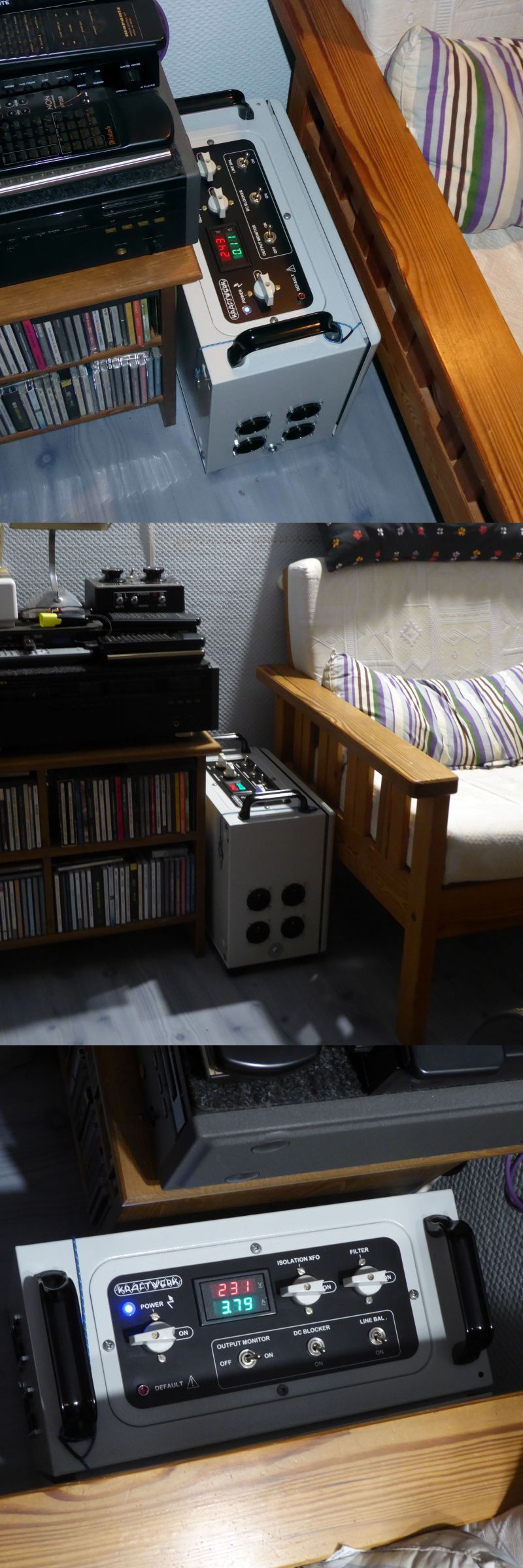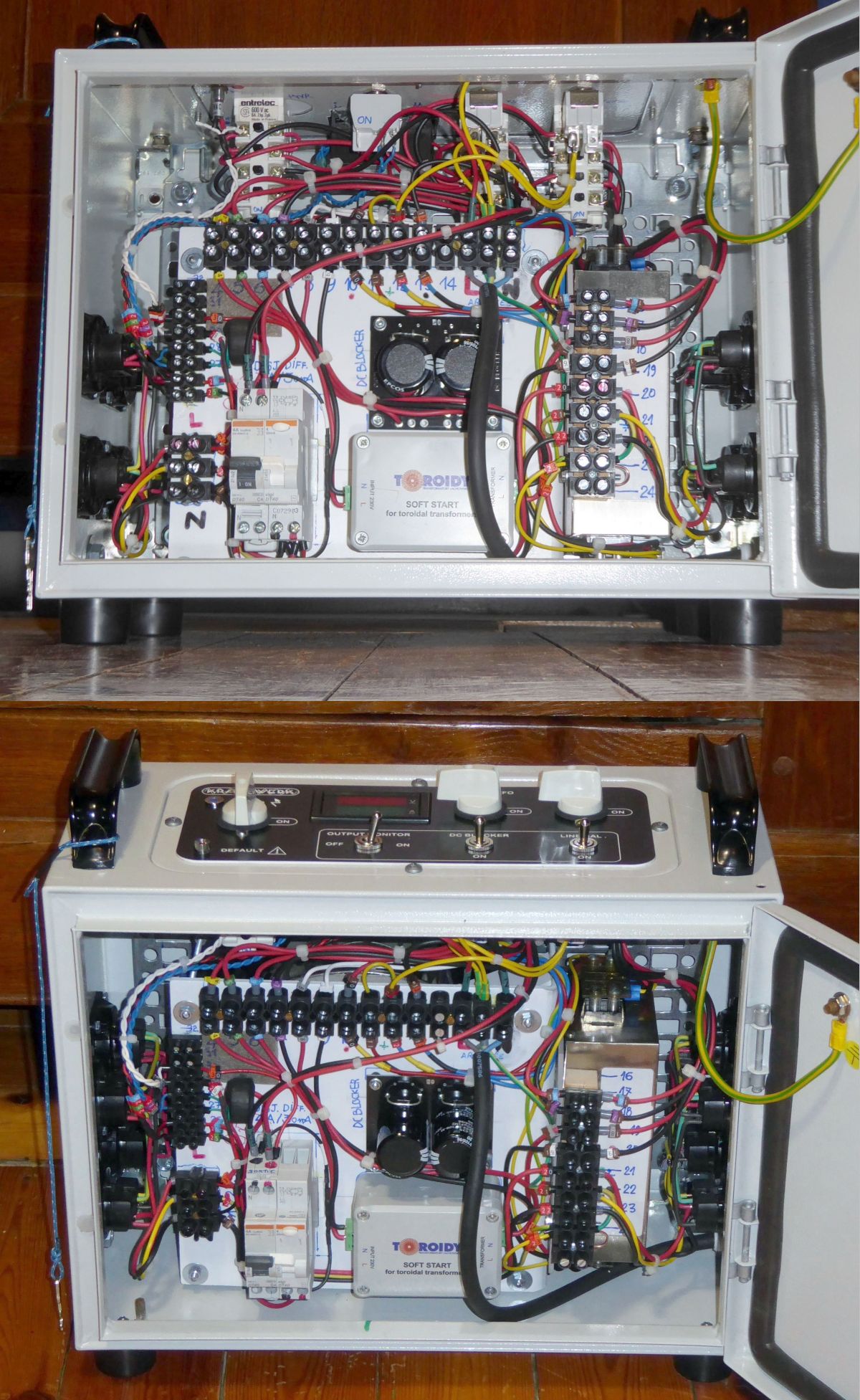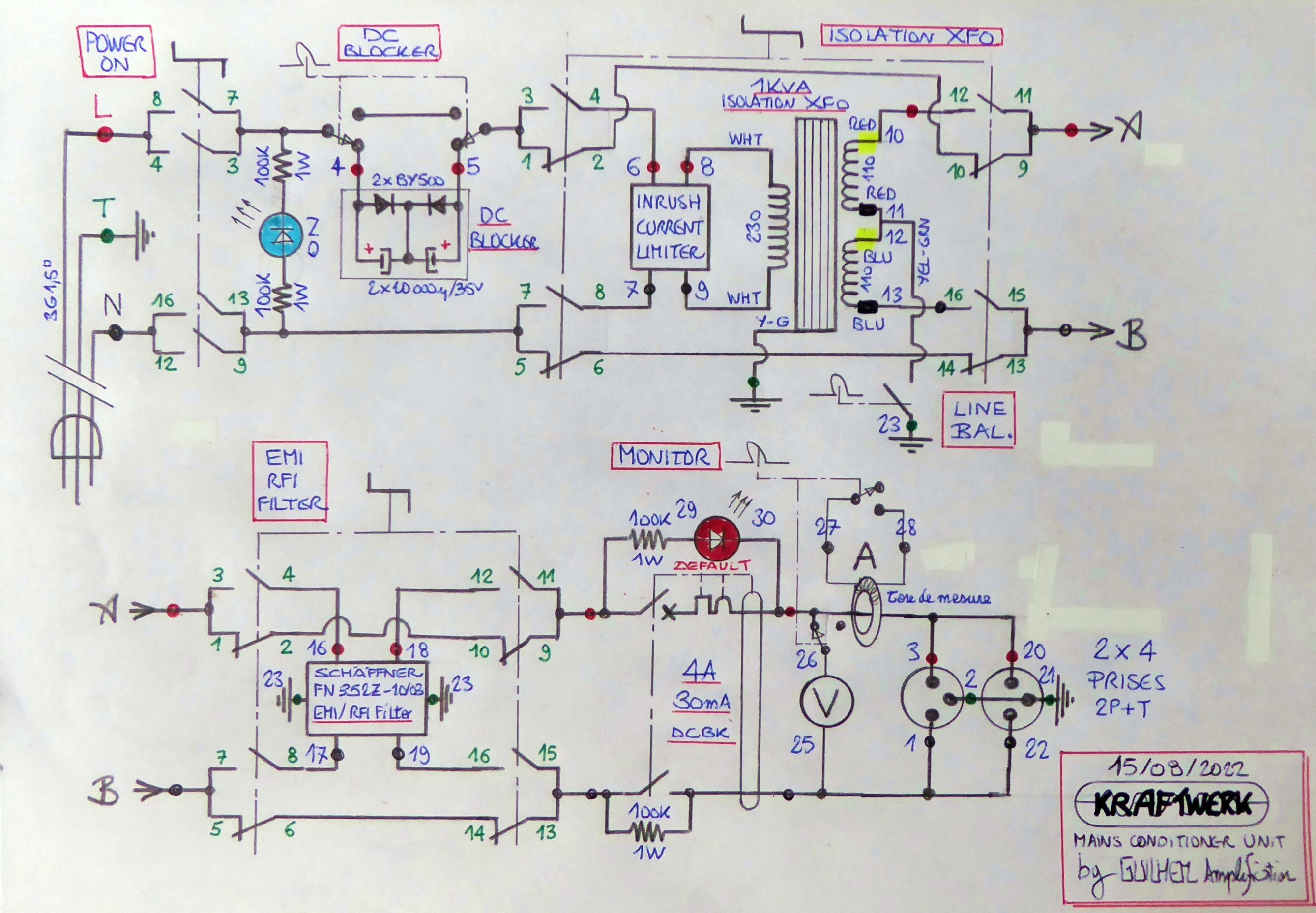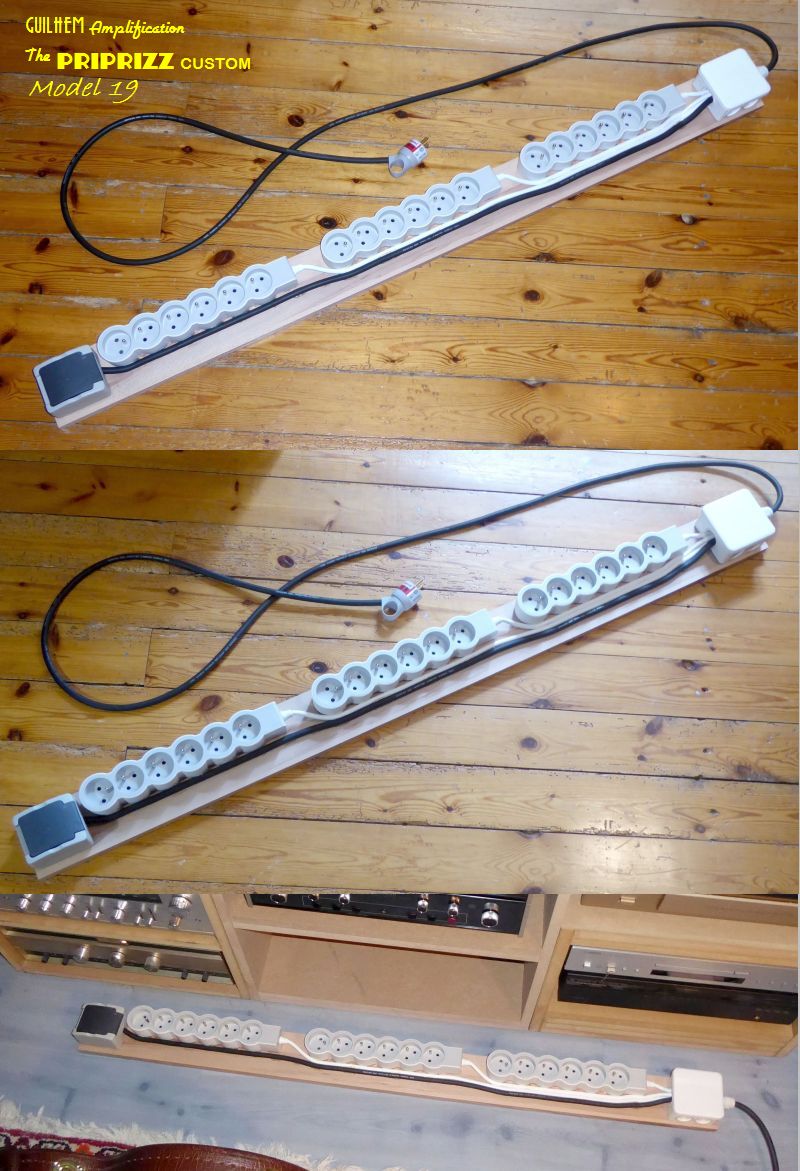I'm wondering if anyone here has actually built/designed a power conditioner. I'm asking because I suspect my main systems have less-than-optimal conditions due to switching power supplies, class D amps, and computers being part of the system.
The prices I see on the ones which look like good quality are sky high. Are they terribly complicated to build?
The prices I see on the ones which look like good quality are sky high. Are they terribly complicated to build?
The conditions may be better or worse but their effect on the sound needs to be verified.I suspect my main systems have less-than-optimal conditions
Some people state that they have heard the difference in sound caused by power cords, some say hearing the difference caused by a power conditioner. Who knows, the truth is "out there".
There are units sold in the net named mains noise analyzers - get one and measure the mains noise at your audio gear power inlet and at some friends' households.
Then take your set to the place with least noise level measured and check if you hear any difference.
Description of your main system would also be a good thing to have.
Personally I played around with an idea of building one but dropped that after a while.
I'm wondering if anyone here has actually built/designed a power conditioner. I'm asking because I suspect my main systems have less-than-optimal conditions due to switching power supplies, class D amps, and computers being part of the system.
The prices I see on the ones which look like good quality are sky high. Are they terribly complicated to build?
Just a bunch of LC filters and MOV.
https://electronics.stackexchange.com/questions/597516/how-to-design-an-emi-filter-for-ac-dc-psu
I use some industrial build power strips with overvoltage protection and a mains filter. These are low priced and well buil, documented with reliable data. The overvoltage protection, in the long-term may be more important than the filter function. I noticed that some switching events in the household that previously could be heard at the speakers, are not comming through any more.
Those are not expensive, starting around 30$ up to 100$, but as soon as they are sold for "HIFI", the prices explode. I prefer something industrial made made with certified data, for computer and other serious gear, to some "special HIEND" voodoo constructions.
There are sometimes good offers at Amazon or eBay, surprisingly many of them are not made in China.
You can not make something like that DIYS as cheap as the industry does, not to mention the legal problems with such a home brew.
Those are not expensive, starting around 30$ up to 100$, but as soon as they are sold for "HIFI", the prices explode. I prefer something industrial made made with certified data, for computer and other serious gear, to some "special HIEND" voodoo constructions.
There are sometimes good offers at Amazon or eBay, surprisingly many of them are not made in China.
You can not make something like that DIYS as cheap as the industry does, not to mention the legal problems with such a home brew.
My concern with adding inductors and caps on mains would be accidentally exciting a resonance circuit. DC filtering is one thing, but AC is another.
I suppose I'm asking for a refresh on the math of it all.
I've hooked my scope up when operating. There's definitely noise there 250 kHz and up.
I have 4 channels of class D, 2kW total, plus a DSP, plus 4 channels of AB, plus a PC with a PFC PS.
My wife is also a CPA who became a CEO of one of the first HMOs in LA but now works for the NSA in DC.
Whew, what a mouthful.
I suppose I'm asking for a refresh on the math of it all.
I've hooked my scope up when operating. There's definitely noise there 250 kHz and up.
I have 4 channels of class D, 2kW total, plus a DSP, plus 4 channels of AB, plus a PC with a PFC PS.
My wife is also a CPA who became a CEO of one of the first HMOs in LA but now works for the NSA in DC.
Whew, what a mouthful.
Last edited:
I'm wondering if anyone here has actually built/designed a power conditioner. I'm asking because I suspect my main systems have less-than-optimal conditions due to switching power supplies, class D amps, and computers being part of the system.
The prices I see on the ones which look like good quality are sky high. Are they terribly complicated to build?
Yes @HerzMeister : me ! 😀 ... I called it The KRAFTWERK Unit... 😉
Details :


In situation and operation :

Inside :

Parts view :

Schematic :

Oh, and of course the essential, indispensable PRIPRIZZZ Custom Model 19, to connect all the gear... 😀


I certainly not saved money by designing / building it by myself, that's a fact... 😕
But I have a "sky high" quality unit that fits my space and need ! 😎
T
Last edited:
Its switch mode class D not much point.
The noise is high frequency.
Long as the amp doesn't have audible hissing in the tweeters.
Low frequency filters wont fix it anyways.
Its the amp and its high frequency.
The noise is high frequency.
Long as the amp doesn't have audible hissing in the tweeters.
Low frequency filters wont fix it anyways.
Its the amp and its high frequency.
One of the best power conditioners ever for audio was "Monster HTPS 7000 Mk II Signature Edition." It was designed for Monster by two fellow forum members, Richard Marsh, and Demian Martin (1audio).
Sometimes you can find that model used on ebay for around $500 or so. Big, yet very soft ferrite common mode chokes, some dual transformers for balanced AC lines, etc. Schematics, such as they are, were posted here in the forum by Richard.
Sometimes you can find that model used on ebay for around $500 or so. Big, yet very soft ferrite common mode chokes, some dual transformers for balanced AC lines, etc. Schematics, such as they are, were posted here in the forum by Richard.
Power Conditioner can mean many different things:
Power Conditioner
In that 'power conditioner' is an undefined term. It could mean almost any combination of the following.
a) Noise filter - a low-pass EMI/RFI filter.
b) Surge protector - although it's better to have surge protection at the home's service entrance.
c) UPS - note that many UPS's are not really UPS's!
d) Line voltage adjuster.
e) Balanced power transformer.
f) Isolated power transformer.
g) DC blockers.
h) Regenerators (PSAudio)
i) Power Factor Correction
j) Sola Constant Voltage Transformers, also called Ferroresonant power conditioners
k) I forget? But I think that there are more.
Most are solutions in search of problems.
Power Conditioner
In that 'power conditioner' is an undefined term. It could mean almost any combination of the following.
a) Noise filter - a low-pass EMI/RFI filter.
b) Surge protector - although it's better to have surge protection at the home's service entrance.
c) UPS - note that many UPS's are not really UPS's!
d) Line voltage adjuster.
e) Balanced power transformer.
f) Isolated power transformer.
g) DC blockers.
h) Regenerators (PSAudio)
i) Power Factor Correction
j) Sola Constant Voltage Transformers, also called Ferroresonant power conditioners
k) I forget? But I think that there are more.
Most are solutions in search of problems.
Common-mode chokes?k) I forget? But I think that there are more.
Regarding CVTs, they tend to produce a distorted output waveform. Can cause more problems than not having them in some equipment.
Balanced transformers are also something that can sometimes help, sometimes hurt, and often not make a lot of difference.
The problem why a lot of PC and laptops cause audible hiss is not because off the mains polution but from erath leakage of their power supplies. The best cure for this is the use of isolators, either in the form of a mains isolation transformer or an USB isolator for instance. The USB isolator is an easier option.
As for off the shelf mains filters, the most common made mistake is choosing a filter with the highest current capability. The current rating of these filters is not only about the current it can handle but it is also about the filtering effect. Using a high current filter on a low power device is not a good choice, it can make things even worse because. Even in case of your 2kW class D amps it is much more effective to use a filter with a 2A rating than one with a 20A rating. 2A is still 460Watts, much more than you will ever use at home. Even a 2A filter has enough current capability to provide a lot more peak power than 460watt. Personally I use a couple of 2A rated Shaffner filters that work a lot better than the 15A filters I used before.
As for off the shelf mains filters, the most common made mistake is choosing a filter with the highest current capability. The current rating of these filters is not only about the current it can handle but it is also about the filtering effect. Using a high current filter on a low power device is not a good choice, it can make things even worse because. Even in case of your 2kW class D amps it is much more effective to use a filter with a 2A rating than one with a 20A rating. 2A is still 460Watts, much more than you will ever use at home. Even a 2A filter has enough current capability to provide a lot more peak power than 460watt. Personally I use a couple of 2A rated Shaffner filters that work a lot better than the 15A filters I used before.
A lot of PCs and laptops have a 2 wire AC cord. Their SMPS dumps/leaks a lot of noise on to the chassis. But the noise currents don't have an easy path back to the AC supply. So the noise goes thru the interconnects to other audio components that have a Safety Ground/Protective Earth wire (back to the AC supply).
Power Conditioner can mean many different things:
Power Conditioner
In that 'power conditioner' is an undefined term. It could mean almost any combination of the following.
a) Noise filter - a low-pass EMI/RFI filter.
b) Surge protector - although it's better to have surge protection at the home's service entrance.
c) UPS - note that many UPS's are not really UPS's!
d) Line voltage adjuster.
e) Balanced power transformer.
f) Isolated power transformer.
g) DC blockers.
h) Regenerators (PSAudio)
i) Power Factor Correction
j) Sola Constant Voltage Transformers, also called Ferroresonant power conditioners
k) I forget? But I think that there are more.
Most are solutions in search of problems.
I agree, even though I always thought as power conditioner a device having in particular with main component a bulky (toroidal) isolation transformer, rated i.e. >1KW, and possibly arranged with various filter topology. Otherwise it's a cute way to call a filtered power strip, unless it has special functions.
I noticed that bigger power strips oftentimes are called power conditioner because their aluminium alloys enclosure and tidy and nice sockets. In this case audiophile market in my opinion reserves notations which some times are much dependent from aestethics.
Absolute beauty! I take my hat off for the craftmanship as displayed. Quality materials all over the place. Form & Function in balance. Practical use as main design criterium. Everything included what could possibly be needed. Bravo!Yes @HerzMeister : me ! 😀 ... I called it The KRAFTWERK Unit... 😉
Details :


In situation and operation :

Inside :

Parts view :

Schematic :

Oh, and of course the essential, indispensable PRIPRIZZZ Custom Model 19, to connect all the gear... 😀


I certainly not saved money by designing / building it by myself, that's a fact... 😕
But I have a "sky high" quality unit that fits my space and need ! 😎
T
The Line Balanced switch is a dangerous one though and the ground fault circuit interrupter should officially be the first in the chain.
Do you notice difference especially when the isolation transformer is in the circuit? And did you test with mains filter at the input?
Last edited:
Absolute beauty! I take my hat off for the craftmanship as displayed. Quality materials all over the place. Form & Function in balance. Practical use as main design criterium. Everything included what could possibly be needed. Bravo!
The Line Balanced switch is a dangerous one though and the ground fault circuit interrupter should officially be the first in the chain.
Do you notice difference especially when the isolation transformer is in the circuit? And did you test with mains filter at the input?
Thanks @jean-paul !
If you look at my schematic, the GND connection is never cut from the grid GND. It's only a balanced / unbalanced function at the secondary of the isolation transformer. I mean : by closing the switch, the secondary of the transformer "re-balances" the GND from the two mains leads. If the switch is left open, the balancing is provided by the mains network... Which is generally poorly balanced !
The 4A differential circuit breaker is here to protect specifocally the Hi-Fi gear, not the rest of the circuit, which is by the way protected online, and has very little chance to become defective by itself. As you can also see, all functions are defeatable.
To be honest, I do not notice huge audible difference... My mains here is usually rather of a good quality, but is high for 230VAC nominal : 240 to 250VAC easily... So the 230V/220V isolation transformer provides a drop of 10VAC, reducing the voltage variation in the 230-240VAC range.
What I notice though, when monitoring the mains with an oscilloscope, is that occasional spikes, pulses, and AF / RF noises are completely eradicated. This can't be bad for the Audio gear, even if it's not always audible.
What I hear though is that when reading digital sources, there's no more "micro-cuts" or "micro-pops", that I think were due to occasional spikes and pulses.
The placement of the elements in the KRAFTWERK follow some logic :
1 - the DC blocker primarily protects the toroidal transformer from DCV intrusion. This type of transformer absolutely dislikes any offset voltage, which generates more important losses and noises than with a classic EI transformer.
2 - the inrush current limiter (soft start) avoid any brutal current call by the 1KVA toroidal transformer, and by the connected Hi-Fi devices.
3 - the Schaffner filter is placed in the latest position, the closest to the Hi-Fi gear connection, to stop any remaining disturbance that would have crossed the isolation transformer and its screen, followed by the circuit breaker and the U I monitoring, to protect and check what's delivered to the gear.
I did not tested to put the Schaffner filter in first position, considering that it was more useful to place it as "final smoothing device", if I can say so, complementing the work of the DC blocker and the isolation transformer.
T
The problem with an isolation transformer used with a secondary middle connection connected is that galvanic isolation is not maintained anymore. And... IMHO nothing is gained with the middle point connection as it is already balanced by nature of the transformer.
The inrush limiter is mandatory above 500VA both by regulation and by your breakers/fuses 😉
The mains filter can be more effective by filtering before the pretty wideband toroid. Closing the entrance for garbage instead of letting it pass. At the output it may prevent feedback by the loads SMPS. So 2 filters!
Just suggestions, I build such devices myself.
The inrush limiter is mandatory above 500VA both by regulation and by your breakers/fuses 😉
The mains filter can be more effective by filtering before the pretty wideband toroid. Closing the entrance for garbage instead of letting it pass. At the output it may prevent feedback by the loads SMPS. So 2 filters!
Just suggestions, I build such devices myself.
The problem with an isolation transformer used with a secondary middle connection connected is that galvanic isolation is not maintained anymore. And... IMHO nothing is gained with the middle point connection as it is already balanced by nature of the transformer.
Galvanic isolation means that there's no common point between premary and secondary of the transformer. In my circuit there's none, no matter the GND balance swithc is closed or opened.
If the balance switch is opened, tha the balance vs. GND is given by the mains (and is usually poor), the secondary of the transformer having no reference to GND. To have the GND balance given by the transformer, the balance switch must be closed, then the center of the secondary becomes the GND reference.
The mains filter can be more effective by filtering before the pretty wideband toroid. Closing the entrance for garbage instead of letting it pass. At the output it may prevent feedback by the loads SMPS. So 2 filters!
No. The best filtering should be placed the closest to the devices to be protected against disturbances.
T
Normally N is connected to PE. This means a connection exists between N and PE at the primary side of the transformer. These are separated by the isolation transformer so L and N at the secondary side are now floating. Isolation transformer so I can touch L or N (never both) standing with bare feet on the ground. What is the situation when the middle point at the secondary side is connected to PE?
Last edited:
Not in user equipment, at least not around here. There is a connection at the power distribution transformer of the power company, and another connection at the service entrance of the facility being served by the power company.Normally N is connected to PE.
Here N is connected to PE in single phase 230V house installations in a few possible ways (depending on EU country/area) but pretty much always. Not in devices of course as that would defy the purpose of PE.
It is safe to state that N is on the same potential as PE regardless of where they are connected.
It is safe to state that N is on the same potential as PE regardless of where they are connected.
Last edited:
- Home
- Design & Build
- Electronic Design
- Has anyone built a power conditioner?